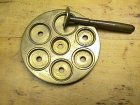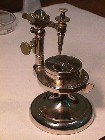Small Tools for Watchmaking
Luthy hairspring vibrating tool
When fitting a hairspring to the balance, it is necessary to select
the proper spring strength and get the length roughly correct. This tool
holds the trial spring attached to the balance by a small clip from above.
The trial balance dangles by the spring with the lower pivot resting on
a glass plate. An adjusted reference balance is mounted under the plate.
A handle on the lower plate lets the operator give both balances a "push"
at the same time. The idea is to watch both balances at once and see if
the reference balance is ahead or behind in oscillation period. This is
easier said than done. In the good old days, vibrating and fitting balance
springs was a specialized craft.
Depthing tool

The depthing tool is used to establish the distance between centers
for a wheel engaging a pinion. Each arbor is held on a pair of centers.
The depth of engagement is determined by adjusting the screw on the front
of the tool. To find the proper depth, the pinion is restrained slightly
with one finger while the wheel is driven with another finger. By adjusting
the depth and feeling the freedom rotation, a good depth can be established.
The center points on the ends of the tool can then be used like compass
points to mark arcs on the watch plate.
In practice, I've found that the alignment of antique depthing tools
leaves much to be desired. I get better results by using the measuring
microscope to see the depth and read off the center distance. A spring
punch attached to the microscope head is then used to mark the plate. I
don't yet have a means to feel the depth while taking the measurement,
but this would be very nice. Anthony Randall has a great method for depthing
in the lathe using a centering microscope. I plan to make a fixture like
his. It is illustrated in volume one of Crom's Horological Tools.
Staking tool

A staking tool set consists of a frame and dozens of "stakes",
which are metal punches shaped to press fit, rivet, & form various
parts of the watch. This example by C&E Marshall also functions as
a small drill press.
Seitz friction jeweling set
In "modern" mechanical watches, the jeweled bearings are pressed into
the watch plate or bridge holes where they are held by friction alone.
The holes must be accurately sized to make this close fit possible. This
tool contains a set of finely graduated reamers and associated fixtures
for sizing holes and pressing the jewels into place.
Poising tool
A balance wheel must be adjusted so it has no heavy spot on the rim
or the watch will run at different rates in different pendant positions.
(Unfortunately, watches like to run at different rates in different positions
for many other reasons.) To poise a balance, it is placed with its
pivots resting on the jeweled jaws of the tool. The balance is then gently
disturbed with a blower or by vibrating the table top. If there is a heavy
spot, it will rotate to the bottom.
Uprighting tool

This is an escapement maker's uprighting tool. It is used to
get a pair of holes lined up in the top and bottom plate of a watch. In
use, the bottom plate has a pilot hole or a punch mark is already in place.
The watch plate is placed flat on the table and the lower sliding center
is moved up to fit in this hole. The upper plate or bridge without a hole
is attached to the bottom plate. The top runner of the tool is then lowered
and the sharp center marks the bridge for drilling.
Wheel stretcher

This tool is used to make a watch wheel slightly larger. The wheel on
its arbor is held between the centers. (The whole tool is clamped in a
vice.) Next, the cross slide is used to position the vertical sliding punch
over the rim of the wheel. The centers are shifted together so the rim
is supported by the anvil from below. The intrepid watchmaker then started
beating on the punch with a hammer while rotating the wheel by hand. The
rim gets slightly smashed and consequently expands. As you can imagine
this takes quite a little skill and the wheel teeth will be totally deformed
in the process. But not to worry: the rounding up tool described above
will reshape the wheel teeth in an instant and the result is a larger,
correctly shaped wheel. More elaborate versions of this tool employ crank-driven
rollers to compress the wheel rim in a continuous operation.
Barrel contractor

The barrel of a watch holds the mainspring. The cover is a disk that
snaps into a turned recess in the top edge of the barrel. Over time and
after repeated replacement of the mainspring, the cover begins to fit loosely.
This tool is used to swage the barrel sides inward. Each of the die holes
has tapered sides. The barrel is placed in a hole that is slightly too
small. The brass punch is used with a hammer to force the barrel into the
die.
Rolltop watchmaker's bench
Where to put all these small tools? This is a late 19th century oak
bench. It was missing the treadle & flywheel stored behind the tall
left side door. I found a very close match that mounted in the same old
screw holes.
It's fun to turn with a foot treadle. The speed control is very precise.
When using the turns, I like to set up the treadle driven counter shaft
with a silk thread to drive the carrier. This make the process a lot easier.









